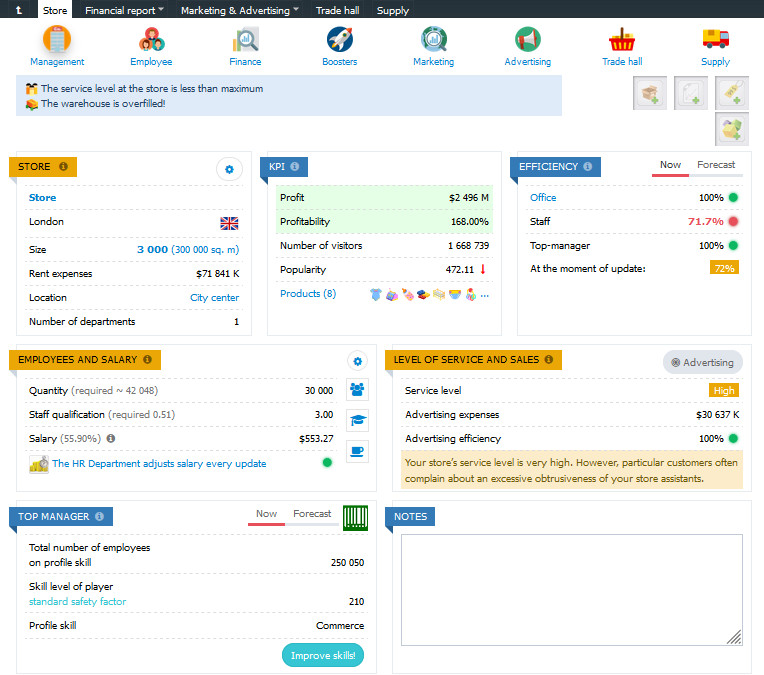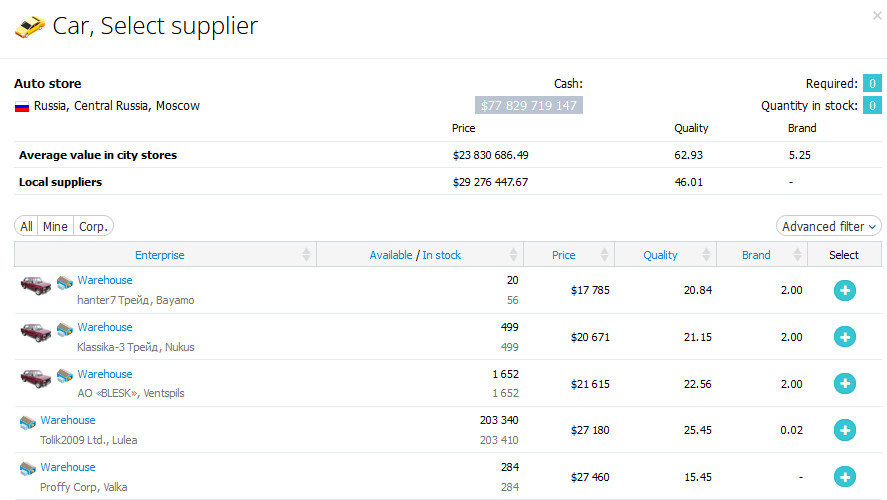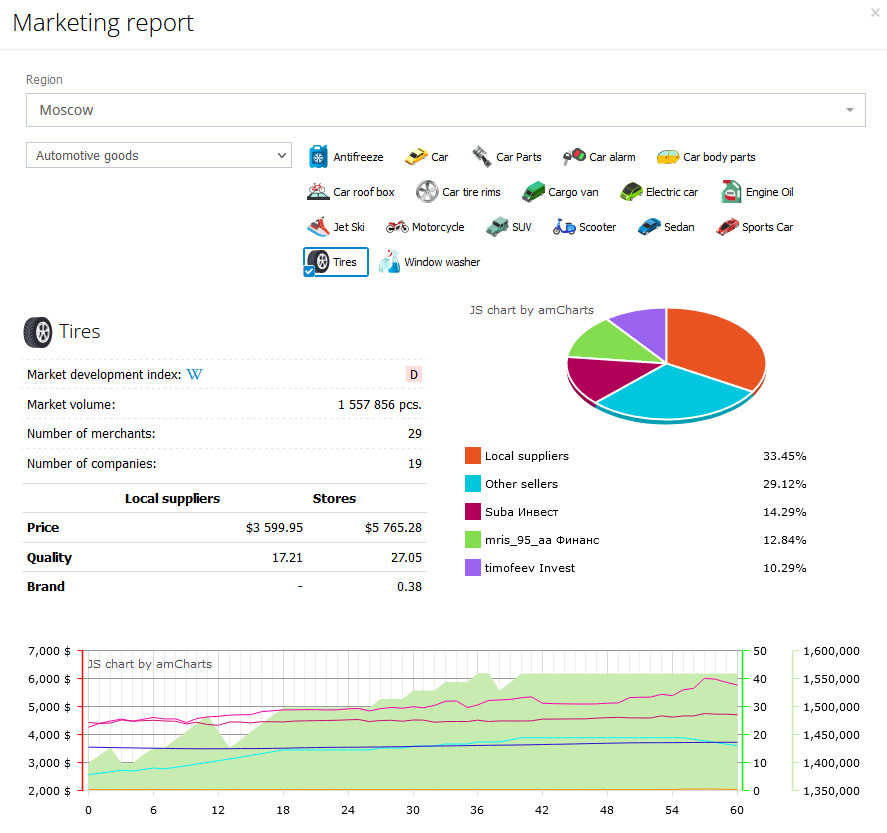- Managing stores in the simulation
- Price, quality, and brand
- What is the most important?
- Ordering supplies
- Important
- Things to consider
- Market analysis and selling potential
- Understanding market analysis data
- Experiment with the market
- Trade hall
- Market Analytics
- Store size and location
- Experiment with the market
- Employees and Salary
- Advertising
- Advertising campaign efficiency
Managing stores in the simulation
An example of how the stores work is shown on your company’s homepage:

Click on “store” and you will receive the information on store’s location, type, and products.

Price, quality, and brand
The business model of the store is quite simple: buying supplies (at a low price) and selling to end consumers (at a higher price). The price margin has to cover all the expenses (rent of the premises, salary, advertising expenses, etc.)
What is the most important?
What is more important: the price, quality, or brand? There is no straightforward answer to that question. For example, if you establish a network of jewelry stores in upscale areas of the city, in that case, the quality and the brand of goods will be very important. However, if your store is located in a residential area, an affordable price will be the key factor.
Do not be afraid to experiment with the prices, quality, and brands.
You can sell various kinds of products in one store. The list of products depends on the game intensity. There is a choice of 205 types of products in Classic format (with daily game turns) and 40 in Intensive (with hourly turns).
Each product has its price, quality, and brand. It depends on the type of product, location of the store, competitors, and other factors.
There are different types of prices in the simulation:
- Supplier’s price — the price of goods, excluding transportation expenses and customs duties.
- Purchase price — the price you are going to pay to the supplier, including transportation expenses and customs taxes.
- Selling price — the price you are going to set for end consumers.
- Average city price — the average price of a specific product in a specific city.
Quality —can be any number (starting from 1 as the lowest quality indicator). The higher the quality is, the better is the product’s selling potential. Brand — the indicator of consumer appeal. The higher the brand is, the better is the product’s selling potential.
Ordering supplies
In order to select the supplier, go to your store, click on the «Supply» tab, select the product category and specify the type of the product, then click on «Select supplier».
Important
The purchase price may differ considerably from the supplier price in case long-distance transportation is required.
When setting up the final price, you should consider such factors as the purchase price, the additional expenses as well as the average city price of the product.
In case there are two products of the same or almost the same quality, you should buy the one with a lower supply price.
If two products have the same or similar price, we buy the highest quality products.

Select the supplier of your choice from the list. Click on «Select», enter the number of units you would like to purchase, and click on «Place an order». You will receive your order after the next game turn.
Things to consider
When signing a contract with a supplier, you can set specific conditions, like stopping the supply in case the price has increased by X%, or stopping the supply in case the product quality has decreased by Y.
All contracts are long-term by default. That is, if you order 100 units, every game turn you will receive precisely 100 items.
If you wish the contract to be valid only for one game turn, tick the “One-time purchase” box.
Price examples of Car supplies.

When you are in the process of selecting products for your store, it is crucial to know whether there is a market demand for these products. Otherwise, there is a risk of investing in a product that will not sell.
Market analysis and selling potential
In order to determine product selling potential, you need to conduct a thorough market analysis as well as a price and quality analysis.
You have established your store in a certain location (country, region, and city). In order to have a clear picture of the market situation, click on «Analytics» > «Market analysis» and select the product and the region.
An example of a market report on Tires in Moscow.

Understanding market analysis data
For quick assessment look at the market development index. If it has a value of “E”, it means there is a selling potential in such a market, since it is occupied only by local suppliers (computer-generated stores, which are relatively easy to compete with). If the development index is “AAA”, it means that there are real players in the market and it will be more difficult to compete. Notice the changes in price and quality. For example, the quality of this product in the market is minimal (1), the price has been decreasing since the last game turns and now it is a bit over 32.
Therefore, if you are able to find a supplier of sausages (or build a sausage factory yourself) with a quality equal to or bigger than 1, but at a lower price, you have an excellent chance to generate profit.
Take a look at the list of the biggest non-computer–generated buyers. They are good indicators of understanding the selling potential of specific products. For example, each game turns “Fedorov and the company” sells about 100 units of 1.05 quality products at the price of 35.99. Therefore, if your product has the same quality, but the price is slightly lower, you can expect to sell 100 units of sausages each game turn.
Experiment with the market
Try to apply various product ranges and price strategies. Experiment with supply and prices and adjust your strategy aftermarket reaction.
In some cases it is better to have a smaller margin (the difference between the selling price and the purchase price), but bigger sales volumes due to the offer of a favorable price / quality / brand combination.
Also, you can choose the strategy of bigger margins and smaller sales volumes.
The following example will help you have a better understanding of the selling potential based on the correlation between product price and quality.
| Product type | Supply | Selling price | City average | Selling potential | ||
| Price | Quality | Price | Quality | |||
| 5 000 | 2 | 8 000 | 8 000 | 1 | Satisfactory: the price is the same as the city average, but the quality is higher | |
| 50 | 1 | 120 | 110 | 1 | Bad: the price is higher than the city average, and the quality is the same | |
| 150 | 5 | 600 | 800 | 2 | Excellent: the quality is higher than the city average, but the price is lower | |
| 50 | 1 | 60 | 60 | 1 | Average: product price and quality are the same as the city’s average | |
| 30 | 3 | 60 | 90 | 3 | Good: the price is lower than the city average but the quality is the same |
Trade hall
When you order the supply, the information on the average city price and quality of the product, your supply and sales volumes, product volumes in stock, etc. can be found in the store’s trade hall. You can set the selling prices of your products in the trade hall of your store.
Market Analytics
Do not forget to refer to the analytics reports in the business simulation. They contain information on market structure, key competitors, and their prices, as well as information on new markets to enter.
Click on «Analytics» for analytics and reference information.
Store size and location
The location of the store is very important. The closer the store is to the city center, the more the quality and the brand of products becomes vital. The further the store is from the city center, the more the product price becomes important.
You can change the location and the size of your store by clicking on «Store location».
Experiment with the market
Experiment with different strategies when selecting the location of the store, product range, and price margins.
The closer the store is to the city center, the higher the rent expenses. But the selling potential is bigger. Especially if your product is of good quality and reasonable price.
As your business starts to grow, there will be a need to increase the size of the store: it will help you sell more products and serve a bigger number of customers. The sign that you need to expand the store will be obvious: you will have long queues of customers in front of your store (there will be a notification of that). It means that the store has substantial customer traffic, a good price and quality correlation, and qualified employees, but the store itself is too small to serve all customers, it means it is time to expand.
Employees and Salary
Naturally, the store cannot function without proper staff. You can manage the HR department of your store by clicking on «Employees and Salary» on the homepage of your store. There you also can find the hint on how many employees your store currently needs.
Set the number of employees and their salary, hire, dismiss, and train your staff.
It is better not to save on your staff expenses and your employees are crucial to your business!
Here are some recommendations for HR management:
- Your employees should correspond to the size, specialization, and growth of your business. For example, if you spend a lot on advertising, make sure you have enough employees to service the increased customer traffic.
- In order to increase the sales volumes, a high level of service is required, which depends on employees’ skills. This factor is especially crucial for the stores, located in the city center or upscale areas.
- Sometimes it is better to decrease the unnecessary supply purchasing (which ties up your money) than save on your employees.
- It is always good to have some options. You can hire expensive yet qualified employees, or you can hire less qualified employees and invest in their training and development. Or you can opt for something in between these two strategies.
- Experiment with managing your HR department, it will help improve the overall efficiency of your staff.
Advertising
Advertising is crucial in attracting potential customers to your store. This eventually might translate into customer traffic and, consequently, bigger sales volumes. In order to set up the advertising campaign for your store, click on «Marketing and advertising».
Try different advertising channels for maximum efficiency.
Advertising campaign efficiency
The more often potential customers see the advertising of your store, the better. Try to maintain a minimum contract figure to the city population ratio: not less than 2: 1 – 3: 1. That is, every resident of the city should see your ad at least 2-3 times.
Ideally, the advertising campaign of your store should be 100% efficient. The efficiency of advertising campaigns does not depend on how much money you have spent on it, but on how efficiently the customers were served in your store after they had seen your ad.
In order to achieve it, it is crucial that your store works with 100% efficiency. This indicator is calculated on a regular basis in the simulation (see. the homepage of your store). The low performance of your store means that not all visitors, who came to your store to buy something, were able to make a purchase.
The efficiency of the store depends on three factors:
- The efficiency of your employees (sales assistants): the number of people and their skills, that is, their ability to provide high-quality customer service.
- Manager’s qualification in Trade (you can see the information on your qualification in “My Company / Top Manager”.)
- The efficiency of your office.
The last two factors will be explained in detail in the following chapters.
 Business games
Business games  Бизнес игры
Бизнес игры  Juegos de negocios
Juegos de negocios  Geschäftsspiele
Geschäftsspiele  Jogos de negócios
Jogos de negócios  Giochi aziendali
Giochi aziendali  Jeux d'entreprise
Jeux d'entreprise  Trò chơi kinh doanh
Trò chơi kinh doanh  ألعاب الأعمال
ألعاب الأعمال  Επιχειρηματικά παιχνίδια
Επιχειρηματικά παιχνίδια  Forretningsspil
Forretningsspil  משחקי עסקים
משחקי עסקים  商业游戏
商业游戏  비즈니스 게임
비즈니스 게임  Permainan perniagaan
Permainan perniagaan  Zakelijke spellen
Zakelijke spellen  Forretningsspill
Forretningsspill  Gry biznesowe
Gry biznesowe  Jocuri de afaceri
Jocuri de afaceri  İş oyunları
İş oyunları  Liiketoimintapelit
Liiketoimintapelit  Obchodní hry
Obchodní hry  Affärsspel
Affärsspel  ビジネスゲーム
ビジネスゲーム